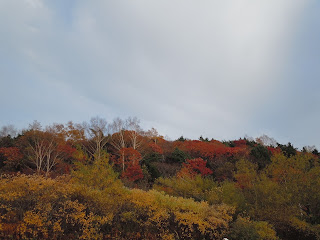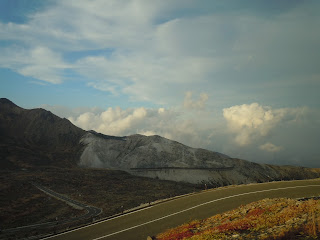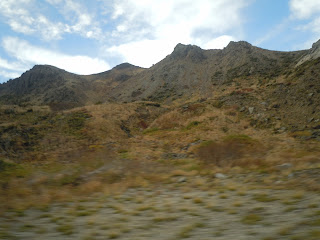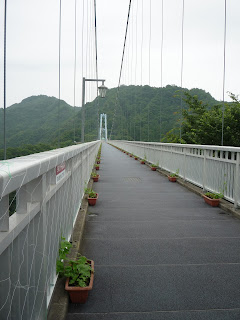Autumn is the season for watching the changing colours and it is one of the most popular travel seasons in Japan. Infact there is a Japanese word for Autumn viewing- "Momiji Gari".
Our first Autumn viewing trip in Japan was to the Bandai area. Bandai area is the region around the Mount Bandai in Fukushima prefecture. This is one of the popular ski resort area in winter. The region is called the Ura Bandai plateau. The region has a lot to offer for travellers- Lake Inawashiro, Lake Hibara, Goshikinuma Ponds, Sky Line, Lake Line, Gold Line and much more. We had travelled to Lake Inawashiro and Goshikinuma Ponds before so this time we decided to do the Sky Line, Lake Line and Gold Line. We had heard that the autumn colours in this region are especially spectacular.
Mount Bandai is 1819 mtrs high and is a volcanic mountain. It has erupted twice in the past , the last being in 1888 when it created widespread damage and the entire vicinity was reported to have been reshaped. The volcanic activity in this area has caused the Goshikinuma ponds and the Hibara lake.
Our first route yesterday was the Gold Line, which offers a scenic view of the Ura Bandai mountain ranges and a view of Lake Inawashiro. The road is a toll road and there are some minor waterfalls along the road. There are photo points and parking spots at many places along the road. We did get to see quite a few Autumn colours as we drove along the Gold Line.
The Gold Line ended near Lake Hibara.
After a lunch stop near Lake Hibara , we started driving on the Bandai Azuma Lake Line. This is a 13.1 km long route which connects the Bandai highlands and the Bandai Azuma Sky Line.We took a photo stop at Bishamon Pond.
The water in this pond appears to be turquoise blue coloured due to the colour of the particles in it. This is part of the Goshikinuma ponds. We had visited the Goshikinuma ponds before so we decided to skip it this time. We then drove past Lake Onogawa, Lake Akimoto, Nakatsugawa Keikoku bridge and some scenic views and photostops later we reached the start point of the Bandai Azuma Sky Line. This definitely was the most scenic and colourful of all the roads we travelled in the Bandai area yesterday.
The Bandai Azuma Skyline is a 28.8 km toll road which is one of the 100 scenic roads in Japan. It connects the towns of Inawashiro and Fukushima and offers a lovely view of the entire area from various viewing points along the road. The autumn colours made the view look like a scene out of a picture book. While driving midway we noticed fumes coming from a mountain.
We did not know that there was an active volcano in the area and it came as a pleasant surprise. Driving ahead we reached Jodo Daira which is the mid poin of the Skyline and is situated 1580 meters above sea level. The Mount Issaikyo ( 1949 mtrs high) and Mt Azuma Kofuji ( 1705 mtrs high) are on both sides. The entire place smells of sulphur and after driving past woods and colourful trees we had suddenly arrived at a barren place with almost no vegetation and an active volcanic eruption.
We saw people taking a short trekking trail upto the crater here . It was almost sunset so we could not do the trail but it is definitely on our to do list.
Driving a few kilometres ahead ,we were back in the world of trees and vegetation and autumn colours.
We reached a place with a cluster of onsens. We did not have time to indulge in a hot water bath but we stopped for a 10 minute foot bath at one of the open air foot baths in the vicinity. A scenic day had ended and it was time to start our drive back home to Iwaki.
Unarguably one of the most scenic places to visit especially in autumn.
Few links which are helpful to plan a trip to the Bandai Azuma area :
Information:
http://www.bandaisan.or.jp/e-bandaisan/English/web-content/04.skyline/skyline.html
http://www.wa-pedia.com/japan-guide/mount_bandai-san_inawashiro-ko_lake.shtml
http://fuku-tabi.jp/en/sightseeing/2010/10/000560.html
Map in English :
http://www.bandaisan.or.jp/e-bandaisan/English/web-content/12.map/azuma.html
For people planning to visit the area and spend a night or two, it would be a good idea to also visit Lake Inawashiro, Goshikinuma ponds and Aizu Wakamatsu town. Apart from Autumn viewing, this region is also a popular skiing area and there are several ski resorts in this area.
Our first Autumn viewing trip in Japan was to the Bandai area. Bandai area is the region around the Mount Bandai in Fukushima prefecture. This is one of the popular ski resort area in winter. The region is called the Ura Bandai plateau. The region has a lot to offer for travellers- Lake Inawashiro, Lake Hibara, Goshikinuma Ponds, Sky Line, Lake Line, Gold Line and much more. We had travelled to Lake Inawashiro and Goshikinuma Ponds before so this time we decided to do the Sky Line, Lake Line and Gold Line. We had heard that the autumn colours in this region are especially spectacular.
Mount Bandai is 1819 mtrs high and is a volcanic mountain. It has erupted twice in the past , the last being in 1888 when it created widespread damage and the entire vicinity was reported to have been reshaped. The volcanic activity in this area has caused the Goshikinuma ponds and the Hibara lake.
Our first route yesterday was the Gold Line, which offers a scenic view of the Ura Bandai mountain ranges and a view of Lake Inawashiro. The road is a toll road and there are some minor waterfalls along the road. There are photo points and parking spots at many places along the road. We did get to see quite a few Autumn colours as we drove along the Gold Line.
The Gold Line ended near Lake Hibara.
After a lunch stop near Lake Hibara , we started driving on the Bandai Azuma Lake Line. This is a 13.1 km long route which connects the Bandai highlands and the Bandai Azuma Sky Line.We took a photo stop at Bishamon Pond.
The water in this pond appears to be turquoise blue coloured due to the colour of the particles in it. This is part of the Goshikinuma ponds. We had visited the Goshikinuma ponds before so we decided to skip it this time. We then drove past Lake Onogawa, Lake Akimoto, Nakatsugawa Keikoku bridge and some scenic views and photostops later we reached the start point of the Bandai Azuma Sky Line. This definitely was the most scenic and colourful of all the roads we travelled in the Bandai area yesterday.
The Bandai Azuma Skyline is a 28.8 km toll road which is one of the 100 scenic roads in Japan. It connects the towns of Inawashiro and Fukushima and offers a lovely view of the entire area from various viewing points along the road. The autumn colours made the view look like a scene out of a picture book. While driving midway we noticed fumes coming from a mountain.
We did not know that there was an active volcano in the area and it came as a pleasant surprise. Driving ahead we reached Jodo Daira which is the mid poin of the Skyline and is situated 1580 meters above sea level. The Mount Issaikyo ( 1949 mtrs high) and Mt Azuma Kofuji ( 1705 mtrs high) are on both sides. The entire place smells of sulphur and after driving past woods and colourful trees we had suddenly arrived at a barren place with almost no vegetation and an active volcanic eruption.
We saw people taking a short trekking trail upto the crater here . It was almost sunset so we could not do the trail but it is definitely on our to do list.
Driving a few kilometres ahead ,we were back in the world of trees and vegetation and autumn colours.
We reached a place with a cluster of onsens. We did not have time to indulge in a hot water bath but we stopped for a 10 minute foot bath at one of the open air foot baths in the vicinity. A scenic day had ended and it was time to start our drive back home to Iwaki.
Unarguably one of the most scenic places to visit especially in autumn.
Few links which are helpful to plan a trip to the Bandai Azuma area :
Information:
http://www.bandaisan.or.jp/e-bandaisan/English/web-content/04.skyline/skyline.html
http://www.wa-pedia.com/japan-guide/mount_bandai-san_inawashiro-ko_lake.shtml
http://fuku-tabi.jp/en/sightseeing/2010/10/000560.html
Map in English :
http://www.bandaisan.or.jp/e-bandaisan/English/web-content/12.map/azuma.html
For people planning to visit the area and spend a night or two, it would be a good idea to also visit Lake Inawashiro, Goshikinuma ponds and Aizu Wakamatsu town. Apart from Autumn viewing, this region is also a popular skiing area and there are several ski resorts in this area.








































